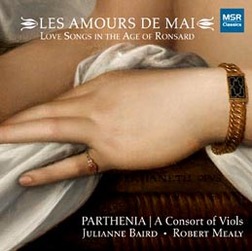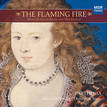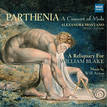PARTHENIA VIOL CONSORTAlso Available
 LES AMOURS DE MAILove Songs in the Age of RonsardPARTHENIA VIOL CONSORT Beverly Au, Bass Viol | Lawrence Lipnik, Tenor Viol Rosamund Morley, Treble Viol | Lisa Terry, Bass Viol Julianne Baird, Soprano [MS1304] $12.95 LISTEN
REVIEWS
"...the performances are done with great delicacy and taste. Soprano Julianne Baird is exquisite... Robert Mealy's beautiful playing overcomes any hesitation might have about the violin blending with viols. Who can complain about a little more fullness and richness with such phrasing and intonation?"MacDonald, VdGSA News - March 2011"Julianne Baird is exquisite, and the four players that make up this consort of viols are superb. The music is largely unfamiliar, not a single duplication on older collections of this period. Specialists will expand their collections with this, and casual collectors will find it agreeable."Weber, Fanfare - January / February 2011"Julianne Baird’s voice is well suited both to this repertoire and to singing with a consort of viols. The backbone of this collection is formed by the consistent musicality of the four gambists of Parthenia plus violinist Robert Mealy. Among the high points are the intricate polyphonic fantasias by Julio Segni da Modean, Gabriel Coste, Claude le Jeune, and particularly five fantasias on the popular song ‘Une Jeune Fillette’ by Eustache du Caurroy... These polyphonic compositions are among the best performances on this recording... This is an important recording for all the first recordings and the musicality of the performers—a “must have” for a serious collector of renaissance music."Brewer, American Record Guide - September / October 2010"...the present CD interweave[s] very pleasantly a selection of monophonic settings by Ronasard’s contemporaries with some of the viol (or viol-friendly) music of the same period. The result is a very satisfying programme, both pleasurable and instructive... Throughout, Julianne Baird sings with an idiomatic expressiveness; she characterises emotion and attitude sufficiently, without compromising the essentially neo-classical air of both texts and music. One particular pleasure is Jean de Castro’s ‘Ah! je meurs’, a delicate piece of bawdy, the opening beautifully phrased to bring out the text’s erotic frisson and the setting’s hesitations and repetitions charmingly made to articulate the would-be temerity of Ronsard’s speaker which is yet rather marvellously united with a genuine air of lamentation. In ‘Mignonne, allons voir si la rose’ by Costeley, Baird and the accompanying strings negotiate Costeley’s complexities with admirable ease. What a fine setting this is!... The viols of Parthenia are exemplary accompanists and play with panache on their own featured pieces... With a good well-balanced, recorded sound this is a rewarding exploration of some important but largely little-known repertoire... But beyond what it has to tell the listener about music history it also, more importantly, is a source of genuine pleasure."Glyn Pursglove, MusicWeb International - September 2010"Here is a delightful collection of mostly French vocal and instrumental music from the second half of the 16th century... Julianne Baird is without question the star of this CD. Besides being a noted scholar on the history and art of singing (her book Introduction to the Art of Singing sits proudly on my shelf), she is one of the most recorded early-music artists around. I was surprised to read in the liner notes that Baird has more than 125 records to her credit, making her one of the world’s 10 most recorded classical artists. The voice [is] beautifully controlled and expressive, with a judicious amount of vibrato. And, as hinted above, she negotiates the coloratura in the Bassano like nobody’s business... The viol consort Parthenia has been around for quite a while, too—more than 20 years. Their unanimity and grasp of the style are not unlike that of a great string quartet playing Mozart or Beethoven. Within the limits of the instrumentation, the accompaniments are exemplary... Nicely done recording, with a believable soundstage and front-to-back perspective between singer and instrumentalists. Recommended."Christopher Brodersen, Fanfare - July / August 2010"Excellent performances."Turok's Choice, Issue No.223 - July 2010PROGRAM NOTES
France in the sixteenth and early seventeenth century was not perhaps the calmest place to make music. Throughout this time, the country was riven by dynastic struggles and wars of religion; assassinations, violent riots, and massacres were not uncommon events. But amidst all this horror, there were songs and dances being made that are marked by a graciousness, a balance, and a wonderful sense of lightness characteristic of the French Renaissance. One can see the same effect in the Louvre that was being built at this time: Italian Renaissance ideas of symmetry, order, and harmonious proportions are realized in a particularly French way to produce an effect of exceptional grace and elegance.The texts that the composers of the French Renaissance chose to set are those from the new generation of poets that were coming of age around them, in particular the poets known as the Pléiade. Most prominent among this constellation was Pierre de Ronsard, who deftly combined a sumptuous vocabulary with graceful imitations of classical metrical patterns to make some of the most memorable lyric poetry of the Renaissance. His works, especially those composed in the decade between 1550 and 1560, caught the ear of composers throughout Europe. The poetic achievements of Ronsard and his contemporaries were matched by an exceptionally talented generation of French composers. Like the architects, the painters, and the poets of France, these composers created their own distinctive styles out of various international elements. Combining the great tradition of well-wrought Flemish counterpoint with newer developments in Italian madrigals, they found a uniquely French Renaissance musical language, one that at times consciously emulated the classical verse forms of the poets they set. Among the most striking of these composers was Claude Le Jeune, a Protestant composer who provided music for the French court and served as maistre des enfants de musique for the Duc d’Anjou, the brother of Henri III. During the siege of Paris in 1590, Le Jeune tried to flee town after a confession de foi made it clear that he was not in sympathy with the increasingly powerful Catholic League. According to Mersenne, Le Jeune’s musical manuscripts were saved from burning by the guards at the city gate only through the intervention of his Catholic colleague Jacques Mauduit. After seeking refuge in the Protestant city of La Rochelle, Le Jeune finally returned to court once Henri de Navarre, the Huguenot successor to Henri III, became the new king; he appointed Le Jeune as maistre compositeur ordinaire de lamusique de nostre chambre. Along with his compositions for the court and his settings of psalms for the Protestant church, Le Jeune also collaborated on some interesting humanist developments in music. During the 1570’s and 80’s, he worked closely with Ronsard’s colleague Jean-Antoine de Baïf to rediscover the power of ancient metrical declamation. The fact that Baïf, a staunch Catholic, had written an enthusiastic sonnet in praise of the massacre of Protestants on St. Bartholomew’s Day seems not to have come between them — perhaps a testament to the potential of art and music to overcome doctrinal conflicts. As an offshoot of the Pléiade and his own humanist interests, Baïf created an Académie demusique et de poésie in 1570. In a way, his project was one of the first attempts at reviving “early music;” a conscious attempt to restore the power of long dead music. This secret society met every Sunday afternoon in Baïf’s townhouse, a beautiful mansion decorated with humanistic inscriptions in Greek, to create a transformative laboratory in which music and verse would come together in perfect harmony. The goal was to reawaken the ethical force of music and, through the proper setting of music and verse, to transform society. The Académie was divided between professional musicians, who were to compose and to perform these works, and auditeurs, noble listeners who would subsidize the endeavor and, in return, be ethically transformed by the experience. Among the enthusiastic listeners at Baïf’s weekly concerts were both Charles IX and his brother Henri III. The musicians involved were, at first, forbidden to disseminate this potentially revolutionary new science beyond the meetings of the Académie, lest this powerful tool fall into the wrong hands. In fact, Baïf’s founding composer, Joachim Thibault de Courville, adhered so strictly to these guidelines that none of his compositions survive. Baïf was lucky to find an especially talented collaborator in Claude le Jeune, who published much of his musique mesurée a l’antique around the turn of the century. His settings of Baïf’s Le Printems was published posthumously in 1603. A preface to this volume discusses the art of musique mesurée, and celebrates Le Jeune’s achievement in being the first to recreate the subtle rhythmic skill of the ancients and to combine it with the harmonic perfection achieved in modern times. PARTHENIA, hailed by The New Yorker as “one of the brightest lights in New York’s early-music scene,” is a dynamic ensemble exploring the extraordinary repertory for viols from Tudor England to the court of Versailles and beyond. Since 1989, this critically acclaimed, New York-based viol consort has been bringing ethereal, spirited, and virtuoso performances, enhanced by a remarkable sense of ensemble, to delighted audiences across the United States and Europe. The group collaborates regularly with the world’s best early music specialists and has been featured in prestigious festivals and concert series such as Music Before 1800, Maverick Concerts, Monadnock Music, Miller Theatre at Columbia University, the Arizona Early Music Society, Connecticut Early Music Festival, the Amherst Early Music Festival, and the Regensburg Tage Alter Musik, and numerous times on both radio and television. Noteworthy among Parthenia’s inventive programs have been presentations of the complete viol fantasies of Henry Purcell at the Cathedral of St. John the Divine, the complete instrumental works of Robert Parsons at Columbia’s Miller Theatre, as well as the popular touring program When Music & Sweet Poetry Agree, a celebration of Elizabethan poetry and music with actor Paul Hecht. Parthenia performs often at The Metropolitan Museum of Art, both in Grace Rainey Rogers Auditorium and in the Museum’s Medieval Sculpture Hall, and appeared in conjunction with the exhibition "Searching for Shakespeare" at the Yale Center for British Art. Parthenia has commissioned, premiered and recorded many new works by composers such as Phil Kline, Brian Fennelly, Will Ayton, Kristin Norderval, Max Lifchitz, David Glaser, Frances White, Paul Richards, Randy Sandke, and Nicholas Patterson. Upcoming projects include a premier of a work by Richard Einhorn with mezzo-soprano Jacqueline Horner- Kwiatek. Parthenia has recorded Within the Labyrinth, Parthenia Sampler, A Reliquary for William Blake, and Trumpet after Dark, with jazz trumpeter Randy Sandke. www.parthenia.org JULIANNE BAIRD, soprano, has been hailed a “national artistic treasure” (The New York Times) and as a “well-nigh peerless performer in the repertory of the baroque.” With more than 125 recordings to her credit on Decca, Deutsche Grammophon, Dorian, Newport Classics and MSR Classics, Julianne Baird is one of the world’s ten most recorded classical artists. She has participated in leading roles in a series of acclaimed recordings of Handel and Gluck operatic premieres. In addition, recent projects include recordings of Handel arias from Alcina and Rinaldo with the Dryden Ensemble and a newly commissioned opera written for her and based on “TheWife of Bath’s Tale” of Chaucer. Julianne Baird is recognized internationally as one whose “virtuosic vocal style is firmly rooted in scholarship.” Her book Introduction to the Art of Singing, Cambridge University Press, now in its third printing, is used by singers and professional schools internationally. “The Musical World of Benjamin Franklin” (CD and Song Book) is published by The Colonial Institute. One of America’s leading historical string players, ROBERT MEALY has been praised for his “imagination, taste, subtlety, and daring” (Boston Globe); The New Yorker described him as “New York’s world-class early music violinist.” He has released more than 50 discs on numerous major labels, ranging from Hildegard of Bingen with Sequentia, to Renaissance consorts with the Boston Camerata, to Rameau operas with Les Arts Florissants. Mr. Mealy has appeared at music festivals from Berkeley to Belgrade, and from Melbourne to Versailles; he has also toured with the Mark Morris Dance Group and accompanied Renée Fleming on the David Letterman Show. In New York, he is a frequent leader and soloist with the New York Collegium, ARTEK, the Clarion Society, and Early Music New York. Since 2004, he has been concertmaster for the distinguished Boston Early Music Festival Orchestra, leading them in their Grammy-nominated recordings of Lully’s Thésée and Psyché and Conradi’s Ariadne. He has appeared frequently as guest director and concertmaster for the Phoenix Symphony and the Colorado Music Festival. A devoted chamber musician, he is a member of the medieval ensemble Fortune’s Wheel, the Renaissance violin band the King’s Noyse, and the 17c ensemble Quicksilver. Mr. Mealy is Adjunct Professor of Music at Yale University where he directs the Yale Collegium and teaches courses on rhetoric and performance; for a decade previously, he directed the Harvard Baroque Orchestra. In 2004, he received Early Music America’s Binkley Award for outstanding teaching at both Harvard and Yale. PROGRAM
CLAUDE LE JEUNE (c.1530–1600)Revecy venir du printans Villageoise de Gascogne Fantasie à 4 JEAN DE CASTRO (c.1540–c.1600) Ah! je meurs GUILLAUME COSTELEY (c.1530–1606) Mignonne, allons voir si la rose FRANÇOIS REGNARD (fl.1573–1579) Petite nymfe folâtre JULIO SEGNI DA MODENA (1498–1561) Ricercar III CLAUDE GOUDIMEL (c.1514–1572) Errant par les champs de la grace Two Anonymous 16th c. Dances Quand j’apperçoy ton beau chef jaunissant GABRIEL COSTE (fl.1538–1543) Ricercar IV Two Anonymous 16th c. Dances GIOVANNI BASSANO (c.1558–1617) Divisions on Frais et Gaillard Divisions on Susanne ung jour ANDRÉ PEVERNAGE (1543–1591) Ces deux yeux bruns/De ces deux yeux Quand je voy tout le monde rire Onques amour ne fut sans grand’ langueur MICHAEL PRAETORIUS (1571–1621) Suite of French Dances Traditional Ma belle si ton ame EUSTACHE DU CAURROY (1549–1609) Five Fantasies on Une Jeune Fillette PIERRE BONNET (fl.1585–1600) Mon père et ma mère Voulez vous donc tousjours, madame Françion vint l’autre jour MSR Classics |




